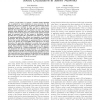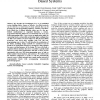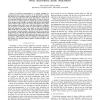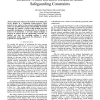IPSN
2005
Springer
14 years 5 months ago
2005
Springer
— In this paper, we propose a quantizer design algorithm that is optimized for source localization in sensor networks. For this application, the goal is to minimize the amount of...
IPSN
2005
Springer
14 years 5 months ago
2005
Springer
—We describe the development of a set of embedded system building blocks, known as eBlocks. An eBlock network can be viewed as a basic form of sensor network that can be develope...
IPSN
2005
Springer
14 years 5 months ago
2005
Springer
— We consider the use of binary proximity sensors for tracking targets. Such sensors provide only 1-bit information regarding a target’s presence or absence in their vicinity, ...
IPSN
2005
Springer
14 years 5 months ago
2005
Springer
— Event-driven programming is a popular paradigm for programming sensor nodes. It is based on the specification of actions (also known as event handlers) which are triggered by ...
IPSN
2005
Springer
14 years 5 months ago
2005
Springer
— Environmental energy is an attractive power source for low power wireless sensor networks. We present Prometheus, a system that intelligently manages energy transfer for perpet...
IPSN
2005
Springer
14 years 5 months ago
2005
Springer
A wireless sensor network consists of a large number of small, resource-constrained devices and usually operates in hostile environments that are prone to link and node failures. ...
IPSN
2005
Springer
14 years 5 months ago
2005
Springer
We address the problem of selecting sensors so as to minimize the error in estimating the position of a target. We consider a generic sensor model where the measurements can be in...
IPSN
2005
Springer
14 years 5 months ago
2005
Springer
Abstract— Recently, several wireless sensor network studies demonstrated large discrepancies between experimentally observed communication properties and properties produced by w...
IPSN
2005
Springer
14 years 5 months ago
2005
Springer
— Lifetime maximization is one key element in the design of sensor-network-based surveillance applications. We propose a protocol for node sleep scheduling that guarantees a boun...
IPSN
2005
Springer
14 years 5 months ago
2005
Springer
: This paper addresses the problem of maximizing the service lifetime of a distributed battery-powered sensor network in the context of the network interdiction problem under user-...




